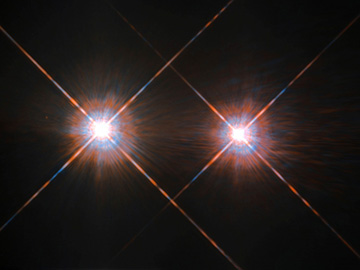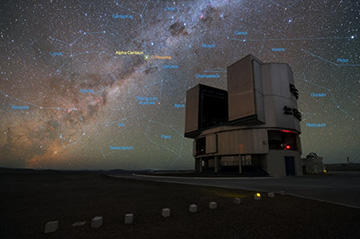To the naked eye, Alpha Centauri is a single bright star, but the system is actually made up of a pair of binary stars, Alpha Centauri A and Alpha Centauri B, plus the faint red dwarf Alpha Centauri C, also known as Proxima Centauri, barely visible in this image. [Image: Yuri Beletsky/LCO/ESO][Enlarge image]
Over the past quarter-century, astronomers have progressed from inferring the presence of extrasolar planets around distant stars to directly imaging some of the largest and hottest of the orbiting bodies. Photographing low-mass, temperate planets that might harbor life has remained challenging, however.
Now a multinational team has upgraded a mid-infrared camera on the Very Large Telescope (VLT) in Chile’s Atacama Desert to image these small, cool planets around nearby stars (Nat. Commun., doi: 10.1038/s41467-021-21176-6). In particular, the researchers have set their sights on the closest stellar system to our own sun: Alpha Centauri.
The team, led by astronomer Kevin Wagner of the University of Arizona, USA, used the upgraded mid-infrared instrument to accumulate 100 hours of observations, which revealed a possible planet around one of the stars in the Alpha Centauri system—or, possibly, an instrumental artifact.
In search of distant Earths
The earliest known exoplanets revealed their presence through indirect evidence, like the apparent wobble of their parent stars as the two bodies orbit their common center of mass. These techniques were heavily biased in favor of fast-moving planets much larger and hotter than Jupiter and unlikely to have surface conditions compatible with life. Astrobiologists say that planets in the “habitable zone,” a range of orbital radii where planets have the right temperature to maintain water in its liquid state, are the most likely places to search for signs of life.
Unlike the large, hot super-Jupiters, more temperate and potentially habitable planets are brightest in the mid-infrared region, with wavelengths from 10 to 20 μm. However, astronomers trying to image substellar companions—even to nearby stars such as Alpha Centauri—face complications such as higher thermal background and coarser spatial resolution than with near-infrared imaging techniques.
NEAR looks at near star

Alpha Centauri A (left) and Alpha Centauri B imaged by the Hubble Space Telescope. The star pair is located in the constellation of Centaurus (the Centaur) at a distance of 4.3 light-years from the sun. [Image: NASA/ESA/Hubble]
The VLT already had a mid-infrared camera operating in the desired wavelength range, so Wagner’s team designed an experimental campaign called New Earths in the Alpha Centauri Region (NEAR) to improve both the imaging technology and the observing strategy.
As part of the Breakthrough Initiatives project (OPN, May 2017), the multinational team added a coronagraph with an annular groove phase mask and shaped-pupil mask optimized for mid-infrared wavelengths. The astronomers also employed a deformable secondary mirror that allowed them to omit corrective optics that couldn’t be cryogenically cooled, and would thus add to the thermal background that they were trying to subtract.
The team observed Alpha Centauri with NEAR for 100 hours over several weeks in May and June 2019. During each observing run, the team performed 10-Hz “chopping,” an astronomical observing technique in which the secondary mirror flips back and forth between the target object and the empty background sky. Chopping helps astronomers subtract out the background signal from the sky, leaving the desired image.
According to Wagner, the innovations in NEAR resulted from the combination of technologies and observing strategies that had not been used together previously. “The wavelength coverage, the coronagraph, the long observing time and the rapid chopping strategy were all new and crucial to the sensitivity,” he says. “The biggest challenge was dealing with the new systematics of all of these new additions. In particular, persistence in the detector as a result of the chopping sequence proved to be quite difficult to deal with.”
Planet or artifact?
After extensive image analysis and processing, the astronomers found a spot they dubbed Candidate 1, or C1, which may be a giant planet with a radius three to 11 times that of Earth at roughly 1.1 astronomical units from the star known as Alpha Centauri A. The object could also be part of a dusty zone called an exozodiacal disk, but until another independent observing campaign is conducted, the NEAR team cannot exclude the possibility that it is some sort of image artifact.
“We accounted for everything that we could identify,” Wagner says. “These included line and arc-like structures, or in other words things that look nothing at all like planets. We aren’t quite ready to rule out the possibility of a systematic effect that we haven’t thought of, though.”
Wagner and his colleagues are eager to follow up NEAR’s observation with others from different observatories. “I think it’s really important to determine whether or not we actually saw anything,” he says. “Beyond that, NEAR has shown that the next generation of extremely large telescopes will be able to image Earth-sized planets in Alpha Centauri’s habitable zone in a matter of hours. That’s something that I’m very excited for.”
Collaborators on the NEAR experiment include researchers from NASA, USA; European Southern Observatory, based in Germany; and additional universities, companies and observatories in Belgium, France, Germany, Sweden, the United States and the Netherlands.

